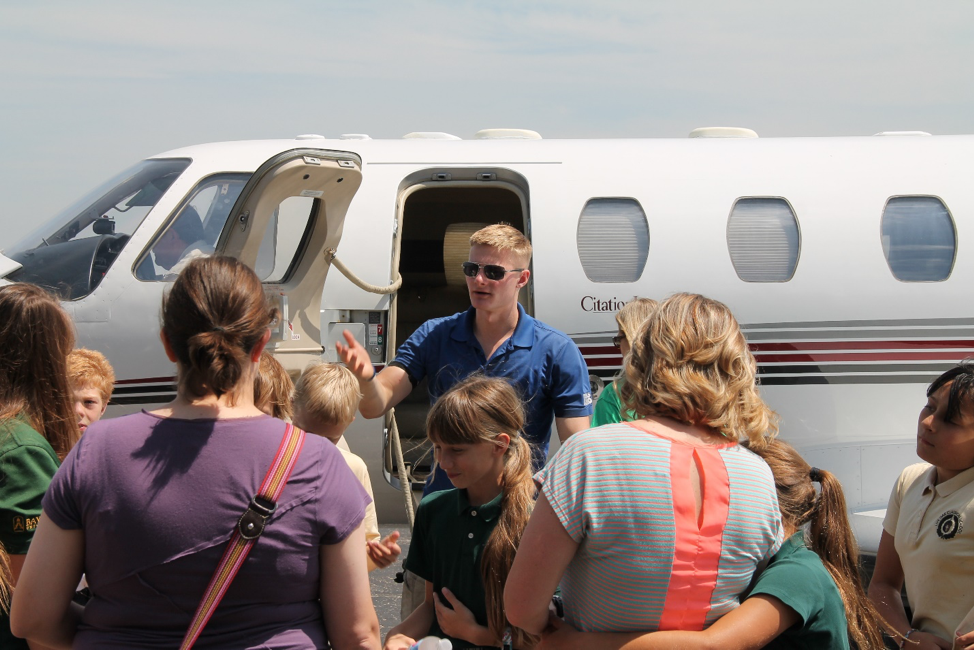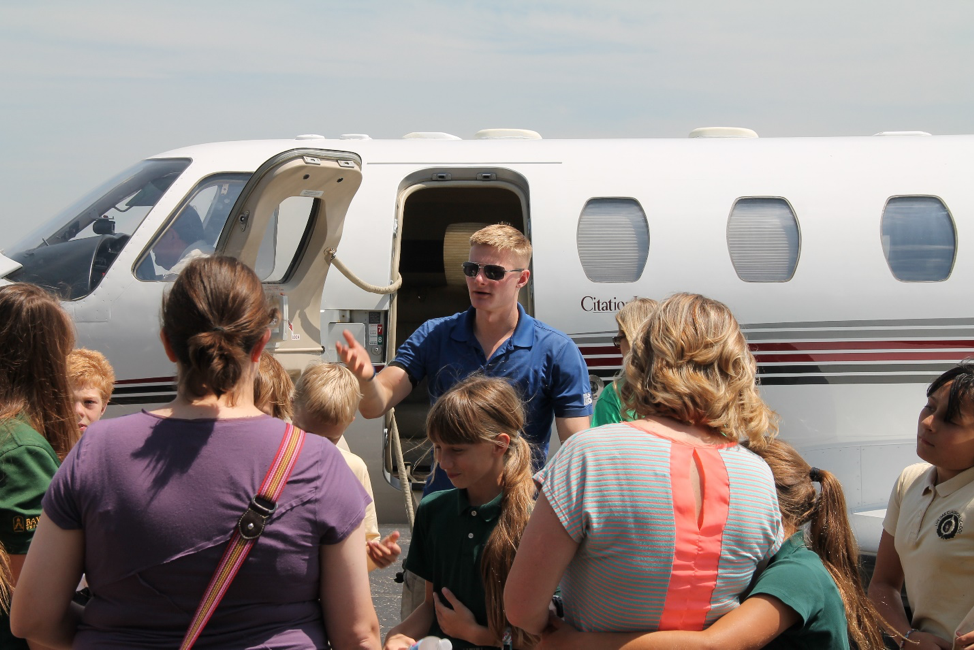Baylor-Organized Tour Aims to Turn Local 4th Graders’ Eyes Toward the Skies


Texas Aero’s Andrew Hill gives Live Oak Classical School students and parents a close-up look at a Cessna Citation Jet as part of the group’s May 16th tour of the Waco Regional Airport.
Contact: Whitney Richter, Director of Marketing and Communications, Office of the Vice Provost for Research, 254-710-7539
Written by: Gary Stokes, Office of the Vice Provost for Research
WACO, Texas (July 10, 2018) – All things aviation was the order of the day for 35 students from Live Oak Classical School who recently enjoyed a field trip to the Waco Regional Airport. The event was organized by BIAS—the Baylor Institute for Air Science—with the assistance and cooperation of the City of Waco, the Federal Aviation Administration, and aviation services company, Texas Aero. Students were treated to a tour that included the airport terminal, fire station, FAA control tower and Texas Aero's fixed-base operation. It's become a regular event that students look forward to each school year.
"Three years ago, one of the teachers at Live Oak, Becky Kahle, reached out to us and said they were doing a teaching block on aviation and asked if maybe we could have someone come out and talk to the students," recalls BIAS director and assistant research professor Dr. Trey Cade. "Then we started thinking about it and talked it over and thought, why don't we take them to the airport? We talked to all the people at the airport and set up a tour, and now this is our third year of doing it."
Having groups of grammar school students milling around a busy airport terminal could prove a little disrupting, but the airport's director of aviation, Joel Martinez, says tours like this one are an important investment that pays off on several levels. Plus, they give him the opportunity to share his enthusiasm for aviation.
"The airport and the city benefit by building citizen awareness. Not only do we have an opportunity to expose our citizens to how an airport operates, we also generate awareness in parents who have residual conversations with their children," Martinez says. "[And] I also see the purpose of airport tours as to hopefully expose youth to a career or passion for aviation, whether it's to be pilot, air-traffic controller, TSA screener, or even an airport director. We sometimes forget what drew us to our current careers or passions."
Several BIAS students who are working toward aviation careers helped conduct the student groups around the airport. Among them was Waco junior Ashley McGill, who enrolled at Baylor on the G.I. Bill after a stint in the U.S. Air Force as an air traffic controller. McGill, who is training to become a helicopter pilot and plans to fly humanitarian missions, enjoyed the opportunity to tell the students about her experiences.
"I think one of the best ways to volunteer your time is mentoring children," she said. "And it was even more exciting for me to get the opportunity teach them about both Air Traffic Control, my first real career and passion, and my new love of aviation."
Because the city-owned airport itself has no airplanes, Texas Aero, the fixed-base operator adjacent to the terminal, opened up its hangars to give students an up-close experience with a variety of aircraft ranging from small, two-place trainers to near-airliner-size corporate jets. They also were given a look at ground power units, fuel trucks and tugs the company uses in servicing aircraft.
The students visited the airport's fire station, which has equipment designed specifically to fight fires of the sort that occur at an airport. Firefighters delighted the students with a demonstration of their massive fire engine's ability to dowse fires by jetting a powerful stream of water from the vehicle's forward nozzle.
As an educator, Becky Kahle is working to ensure that her Live Oak students get a well-rounded worldview that will broaden the opportunities they will have in choosing a career that will be rewarding and of service to society. The tours support that goal.
"We do a short unit on flight at the end of the year," Kahle said. "This trip stirs up excitement on the unit, and it shows students things that I would not be able to in the classroom. There's no replacement for learning firsthand from people who have flown planes or work at the airport. We've also received workbooks from [BIAS] that we use in the classroom to learn more about flight, planes, and helicopters."
At a time when military, commercial, corporate and charter flight operations all face an increasingly critical shortfall in the number of qualified pilots, cultivating an interest in aviation is a matter of national interest and security. Cade hopes the tours have an inspirational effect beyond the educational experience.
"It's hard to gauge with kids this age what the long-term impact is going to be. But if nothing else, just the hope that the exposure to aviation industry and talking to Baylor aviation sciences students will get them to realize, 'Hey, this is something I can really do! I can go to school in aviation, get a degree and work in the industry.' Just that exposure may light a spark in a few students," Cade said.
The Baylor Institute for Air Science operates under the auspices of the Baylor University Office of the Vice Provost for Research.